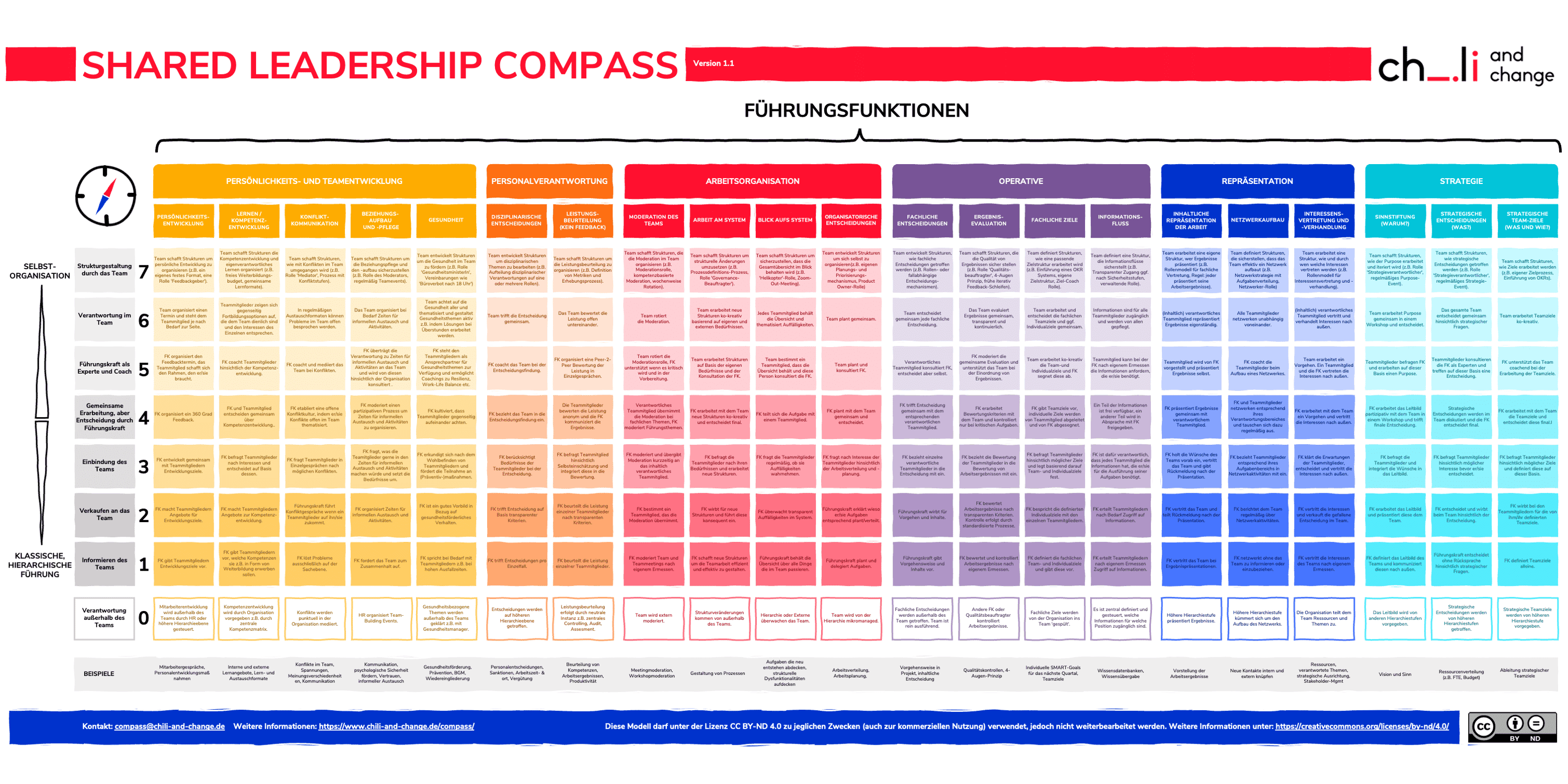How does a radically self-organised team work?
You have probably encountered the term “self-organisation” several times in the agile universe. Although the word seems self-explanatory at first glance, there are different approaches, views and definitions in lived practice, so that the true meaning in everyday life remains unclear for many people.
In order to give you an insight into the possibilities and limits of self-organisation, I would like to report in this article something about everyday life in a radically self-organised team, namely our own.
Self-organisation as a consciously chosen form of work
In 2018, our company Chili & Change was founded with a focus on organisational development and leadership in dynamic contexts. The two founders of the company, who legally act as managing directors, had a self-organised company in mind from the very beginning, in which leadership can be exercised by all employees. The two had already had good experiences with self-organisation as a form of work in their previous company with 20 equal founders. Self-organisation at Chili & Change means that
- leadership tasks and
- responsibility,
which traditionally lie with the manager, are shared within the team. As team members, we decide which tasks we take on, which client projects we carry out, which people we hire, when we spend budgets and how we manage our working hours or holidays.
Self-organisation with structures and roles
We live self-organisation in such a way that leadership tasks are shared within the team instead of being tied to a person or position, for example. But so that we do not sink into the chaos of self-delegation, we also have
- structures,
- processes,
- roles and
- rules.
When introducing structures, processes or rules, we are guided by the principle of “safe enough to try”. It is important that the structures, processes or rules serve the team, facilitate value creation and are in line with our principles. We always proceed step by step and start with an inventory. Based on concrete needs for change, we make adjustments, which we then test over several months, check, adjust if necessary or even discard. In this way we ensure that self-organisation does not become an end in itself.
Two points are essential for our role model:
- A role always has a specific purpose, a raison d’être. Responsibilities and tasks result from the purpose.
- If a person has a role, this does not necessarily mean that he or she has to carry out the tasks alone, but he or she is responsible for the execution.
For example, a role has the task of keeping an eye on team development. If a person takes on this role, he or she will, for example, enquire about further development wishes and needs, and organise learning sessions or advanced training for the team or individual members, if necessary.
Another role coordinates payment transactions, communicates with the accounting department and creates the space to develop the salary and bonus model together as a team. In the spirit of collective responsibility, we give everyone a share in the financial success of the company and do without individual bonuses.
Basically, our role model is very flexible. It prevents bottlenecks from forming in larger projects or during longer absences such as parental leave. In such a case, a role can be transferred to another person and there are no problems with responsibilities or idle tasks. This is particularly important in the complex challenges we face with our clients.
The Shared Leadership Compass
To support leaders, counsellors, coaches and teams in finding the right level of self-organisation for their context, we have developed the Shared Leadership Compass¹.
- personality and team development,
- personnel responsibility,
- work organisation,
- operational activities,
- external representation and
- strategy.
These leadership functions are subdivided into 21 tasks, such as competence development, conflict communication, health, disciplinary decisions, performance appraisal, work on the system, professional goals, professional decisions, presentation of the work in terms of content, network building or strategic decisions.
These leadership tasks can be “done” by someone being freely responsible for them within the framework of a defined role. In essence, this means that a role holder defines structures together with the team, manages processes, introduces rules and ensures that the tasks are completed. In this way, we guide each other in different contexts, especially since decisions are not dependent on people, not even on the two founders of the company.
Possibilities and limits of our self-organisation
The Shared Leadership Compass provides a basis for increasing self-organisation within individual areas in a structured way. It facilitates stocktaking and dialogue about which tasks can be distributed and how. Interestingly, most teams today already take on parts of the tasks recorded in the Compass without always being aware of it.
Through gradual introduction, iterative adaptation and expansion, the degree of self-organisation develops in the context of the teams. Organically. Without “change fatigue”, where too many parallel changes overwhelm a team. Practice shows that it is helpful to look back regularly, to celebrate successes and failures equally as learnings. This keeps motivation high, leads to continuous development of one’s own work organisation and strengthens self-reflection – crucial ingredients on the way to more self-organisation.
Certainly, this form of self-organisation is not suitable for all organisations and teams. Pure self-organisation works primarily in complex environments and less in complicated contexts. So if (see also the Cynefin model²) cause and effect have a plannable relationship and the environment is thus more complicated than complex, other forms of work organisation, such as those found in classic organisations, may be the better choice. Nevertheless, due to increasing globalisation, digitalisation and current crises, the degree of complexity is increasing rather than decreasing.
In addition, it makes sense to take a close look at how more self-organisation can help the team to create better value. For example, whether more responsibility can be shared within the team, thus streamlining processes and reducing bottlenecks. Or tasks can be organised and distributed independently in order to have more leeway for responding to customer needs.
Outlook
We will continue to move steadily towards self-organisation. We want to leave behind outdated patterns in order to further expand the value-added and satisfying cooperation in our teams. We look forward to welcoming new colleagues to the team in the coming months and are curious to see how the structures will prove themselves in the new constellation.
I would like to encourage you to take a close look at whether a more or less radical pinch of self-organisation here and there might not do your team or organisation good in terms of value creation and satisfaction. It could be worthwhile…
Notes:
[1] The Shared Leadership Compass is published under a CC-BY-ND 4.0 licence and may be used free of charge, with full attribution, for any purpose (including commercial), but may not be modified or further adapted. Further information in German can be found at https://chili-and-change.de/shared-leadership-compass//.
[2] Cynefin-Framework
If you like the post or want to discuss it, feel free to share it with your network.
Leonie Heiss has published another article in the t2informatik Blog:

Leonie Heiss
Leonie Heiss is a Senior Agile Coach at Chili & Change and accompanies teams and organisations in change processes from team building to strategy development.
Her central topics are self-organisation, digitalisation and innovation with a focus on the sustainable change of cooperation structures from a systemic perspective.
Her methods range from design thinking to corporate foresight and are applied pragmatically and according to the motto “all models are wrong, some are helpful”.

